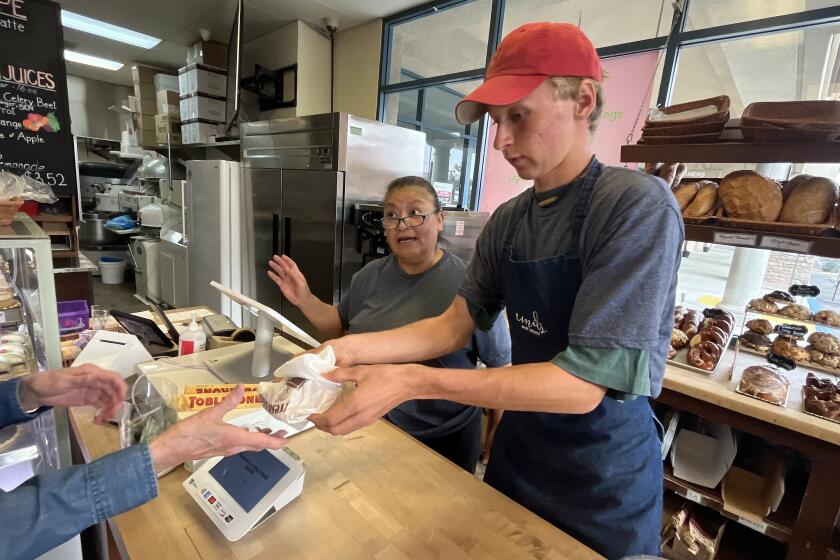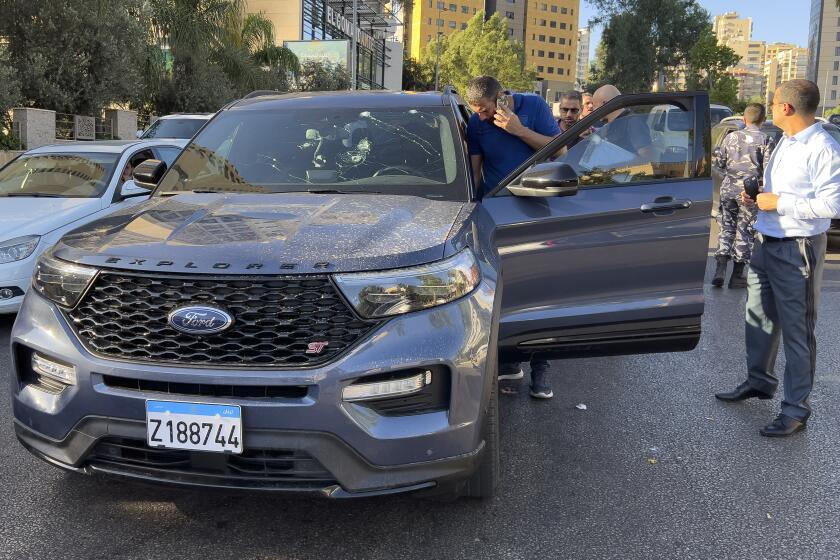Quake Rescue Anxiety Grows
President Pervez Musharraf pleaded for international help Sunday to hurry rescue equipment and relief supplies to tens of thousands of earthquake victims in Pakistan, while desperate survivors begged for government aid that still had not arrived in large areas of the quake zone.
As the confirmed death toll neared 20,000 and threatened to grow, Musharraf asked the United States, Britain and other international donors to send heavy-lift helicopters, financial aid, medical supplies and tents following Saturday’s magnitude 7.6 temblor. The Pentagon promised delivery today of eight military choppers from Afghanistan.
The helicopters, needed to get heavy equipment to remote areas where rescuers were working with little more than hand tools, may be too late for hundreds of children trapped in collapsed schools across northern Pakistan. The quake struck just after 8:50 a.m. Saturday, as classes were about to begin.
At the ruins of the Shaheen Private School in the devastated northern town of Balakot, survivors exhausted from hours of trying to unearth students by hand listened helplessly Sunday as trapped children pleaded for rescue and struggled to survive under the rubble. Residents waited amid corpses covered by battered sheets of corrugated tin roofing and complained bitterly about the lack of outside help.
“They are alive, but we do not have the expertise to get them out,” said a dejected woman sitting on the school’s roof, which lay across the rubble of walls shattered by the quake.
One resident said a child under the rubble had called out his own name, Khizer, for two hours. Then there was silence.
Residents feared that more than 1,000 children were trapped in the debris of Shaheen and two other schools in Balakot, which was flattened by the quake’s force.
Several people in the town, about 70 miles north of Islamabad, the capital, cursed the government for not reaching the trapped people of Balakot in time to save more lives.
“All we could see for the whole day is just two military helicopters,” said Sajid Hussain, a resident. “We whistled and waved to them, but they vanished.”
The bodies of at least 400 children were recovered from two other destroyed schools in Pakistan’s North-West Frontier Province, where Balakot is located. Rescuers had been able to pull dozens of children out alive from some of the collapsed schools.
Almost two days after the quake, the full scale of the disaster was still slowly unfolding. Military rescue and relief teams in Pakistan and India struggled to overcome bad weather, avalanches, cracked roads and bridges, and towering mountains to reach devastated areas.
Across the earthquake zone on Sunday, hundreds of thousands of people spent a chilly night in the open because their homes were damaged or because they feared deadly aftershocks. Severe shortages of food and water were reported.
“Affected people have no shelter, no drinking water, no first aid, and aid agencies have yet to start activities,” said Najeeb Ahmad, who has worked with relief organizations in the town of Abbottabad, about 30 miles south of Balakot. “I slept in my car because of the continuous aftershocks.”
The regional Ayub Medical Complex in Abbottabad was inundated with an estimated 1,000 patients, as doctors treated the injured in the hospital’s outdoor compound. The town had been without power since the earthquake.
By Sunday afternoon, the confirmed toll in Pakistan was at least 19,136 dead and 42,397 injured, Interior Minister Aftab Sherpao told reporters.
“It is such a horrendous situation that one cannot imagine,” he said. “Casualties are increasing by the hour.”
More than 465 people died in India and four in Afghanistan. The United Nations has estimated that more than 2.5 million people need shelter because of the extensive damage caused by the quake.
In response to the Pakistani pleas for help, the Pentagon announced Sunday that it would send five CH-47 Chinook helicopters and three UH-60 Black Hawk helicopters and their crews from Afghanistan. The helicopters are scheduled to arrive today, and more aid could follow, the U.S. military said.
The Chinook is a big, twin-rotor, heavy-lift helicopter used to transport cargo, weapons and troops. The Black Hawk is a utility helicopter normally used for missions ranging from air assault to medical evacuation.
The Pentagon said that sending the helicopters and their crews would not undercut U.S. military operations in Afghanistan, where about 18,000 American troops are battling insurgents and supporting reconstruction efforts. The helicopters will be used on rescue, recovery and supply missions.
President Bush on Sunday invited the ranking Pakistani diplomat to the White House and spoke on the telephone with Musharraf, assuring him of U.S. support.
“I expressed our nation’s deepest condolences,” Bush said of his conversation with the Pakistani president. “And I told him that we want to help in any way we can. To that end, we’ve already started to send cash money and other equipment and goods that is going to be needed to help the people in Pakistan.”
The statements came after Musharraf’s plea for international help, which singled out the U.S. and Britain as having transport helicopters big enough to lift heavy equipment into vast, mountainous areas cut off by the quake.
“We can only go by roads, and roads also don’t reach to every corner, so therefore it’s only helicopter access that we have,” the Pakistan president said during an interview with reporters in Rawalpindi, a suburb of the capital. “Things are not as simple as one would see in the West.”
“We have enough manpower, but we need financial support so that we may utilize it in a required way to cope with the tragedy,” the Pakistani leader said.
Musharraf, an army general who seized power in a 1999 coup, ordered the armed forces to lead the rescue and relief effort just hours after the earthquake.
On Sunday, a second British rescue team, with 70 members and sniffer dogs, arrived to help Pakistanis search for victims. The first British team, which arrived Saturday, joined rescue efforts at the ruins of a nine-story high-rise apartment building.
At least two survivors, a woman and a child, were brought out of the rubble alive Sunday, after crews worked through the night with sledgehammers, shovels and cranes. As many as 50 people, including foreign nationals, are believed to be buried under concrete slabs.
The disputed territory of Kashmir, over which India and Pakistan both claim sovereignty, was one of the regions hardest hit by the temblor. The epicenter was near Muzaffarabad, capital of Pakistani-controlled Kashmir, where scores of buildings were destroyed and hundreds of people were killed.
Across the Line of Control that divides Kashmir, the quake was so powerful in the Indian-controlled zone that there was a roar and Bashir Hussain Shah thought his village, about 120 miles south of Srinagar, had come under artillery fire from Pakistani troops. Shah’s three-story house collapsed and his 13-year-old son Tahir was missing somewhere on the path he took through a mountain valley on his way to his 7th grade class.
Relatives found the teen 2 1/2 hours later, with a fractured leg, shattered jaw and smashed teeth, along with other injuries. He was lying unconscious beneath a pile of rocks.
Relatives made a makeshift stretcher out of sacks and carried him to an Indian army relief camp, where the family was evacuated by helicopter and truck to Srinagar, summer capital of Indian-held Kashmir.
In Baramulla, about 25 miles north of Srinagar, doctors said many of some 340 earthquake victims had only minor physical injuries but were deeply traumatized by the catastrophe.
They complained of chest pains, palpitations and breathlessness, and some were unable to move, said Dr. Sayed Massoud, assistant surgeon at the district hospital.
There were at least 10 strong aftershocks in the region Sunday. Altaf Hussain Shah, who has been an ambulance driver in the Kashmir war zone for 15 years, said he had never seen anything like the emotional stress the quake had caused.
“The relatives who bring injured patients in are themselves shellshocked. They’re completely dazed,” Shah said.
*
Times staff writer Watson reported from New Delhi, special correspondents Zaidi from Balakot and Choudhury from Srinagar and Baramulla. Staff writer Ricardo Alonso-Zaldivar in Washington and special correspondent Zulfiqar Ali in Peshawar, Pakistan, contributed to this report.
*
How to help
These are some of the aid agencies accepting contributions for assistance
to those affected by the earthquake in South Asia.
American Red Cross
International Response Fund
P.O. Box 37243
Washington, DC 20013
(800) HELP-NOW
www.redcross.org
*
Relief International
1575 Westwood Boulevard
Suite 200
Los Angeles, CA 90024
(310) 478-1200, (800) 573-3332
www.ri.org
*
Oxfam America
P.O. Box 1211
Albert Lea, MN 56007-1211
(800) 77-OXFAM
www.oxfamamerica.org
*
Save the Children
54 Wilton Road
Westport, CT 06880
(800) SAVE-THE-CHILDREN
www.savethechildren.org
*
In addition, the Pakistani Consulate has set up a bank account for donations for disaster relief. The consulate’s telephone numbers are (310) 441-5145 and (310) 446-6695
Los Angeles Times
More to Read
Sign up for Essential California
The most important California stories and recommendations in your inbox every morning.
You may occasionally receive promotional content from the Los Angeles Times.










